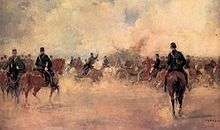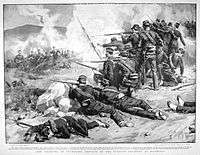Greco-Turkish War (1897)
| Greco-Turkish War (1897) | |||||||
|---|---|---|---|---|---|---|---|
| Part of the Greco-Turkish wars | |||||||
 Painting of the Battle of Velestino | |||||||
| |||||||
| Belligerents | |||||||
|
|
| ||||||
| Commanders and leaders | |||||||
|
Ahmed Hifzi Pasha Edhem Pasha Admiral Hasan Rami Pasha |
Crown Prince Constantine Konstantinos Sapountzakis | ||||||
| Strength | |||||||
|
120,000 infantry[4] 1,300 cavalry 210 guns |
75,000 infantry[4] 500 cavalry 136 guns | ||||||
| Casualties and losses | |||||||
| Unknown | Unknown | ||||||
The Greco-Turkish War of 1897, also called the Thirty Days' War and known in Greece as the Black '97 (Greek: Μαύρο '97, Mauro '97) or the Unfortunate War (Ατυχής πόλεμος, Atychis polemos), was a war fought between the Kingdom of Greece and Ottoman Empire. Its immediate cause was the question over the status of the Ottoman province of Crete, whose Greek majority long desired union with Greece. Despite a decisive Ottoman military victory, an autonomous Cretan State under Ottoman suzerainty was established the following year (as a result of the intervention of the Great Powers after the war), with Prince George of Greece and Denmark as its first High Commissioner. This was the first war effort in which the military and political personnel of Greece were put to test since the Greek War of Independence in 1821.
Background
In 1878 the Ottoman Empire, according to the provisions of the Congress of Berlin, signed the Pact of Halepa which entailed the implementation of the organic law of 1868, promised but never implemented by the Ottoman government, which was to give Crete a status of wide-ranging autonomy. The Ottoman commissioners, however, repeatedly ignored the convention, causing three successive rebellions in 1885, 1888 and 1889. In 1894 Sultan Abdul Hamid II re-appointed Alexander Karatheodori Pasha as governor of Crete, but Karatheodori's zeal for the implementation of the agreement was met with fury by the Muslim population of the island and led to renewed clashes between the Greek and Turkish communities there in 1896 (the latter actually tending to be Greek Muslims of Cretan Greek convert origin).
To quell the unrest, Ottoman military reinforcements arrived while Greek volunteers landed on the island to support the Greek population. At the same time the fleets of the Great Powers patrolled the Cretan waters, leading to further escalation. Nevertheless, an agreement was reached with the Sultan and the tensions receded. In January 1897 inter-communal violence broke out as both sides tried to consolidate their grip on power. The Christian district of Chania was set on fire and many fled to the foreign fleet anchored outside the city. A struggle for independence and union with Greece was declared by Cretan revolutionaries.
Greek Prime Minister Theodoros Deligiannis was subjected to fierce criticism by his adversary Dimitrios Rallis over his alleged inability to handle the issue. Continuous demonstrations in Athens accused King George I and the government of betrayal of the Cretan cause. The National Society, a nationalistic, militaristic organization that had infiltrated all levels of the army and bureaucracy, pushed for immediate confrontation with the Ottomans.
Prelude to war

On 25 January 1897 the first troopships, accompanied by the battleship Hydra, sailed for Crete, where they disembarked two battalions of the Greek Army under Col. Timoleon Vassos outside Chania. On 2 February, despite the guarantees given by the Great Powers on the Ottoman sovereignty over the island, Vassos unilaterally proclaimed its union with Greece. The Powers reacted by demanding that Deligiannis immediately withdraw Greek forces from the island in exchange for a statute of autonomy. The demand was rejected, and on 7 February the first full-scale battle between Greeks and Turks occurred, when the Greek expeditionary force in Crete defeated a 4,000-strong Ottoman force at the Battle of Livadeia, Crete.
Opposing forces


The Greek army was made of three divisions, with two of them taking positions in Thessaly and one in Arta, Epirus. Crown Prince Constantine was the only general in the army. He took command of the forces on 25 March. The Greek army in Thessaly consisted of 45,000 men,[5] 500 cavalry and 96 guns, while that of Epirus comprised 16,000 men and 40 guns.
The opposing Ottoman army consisted of eight infantry divisions and one cavalry. In the Thessaly front it consisted of 58,000 men,[5] 1,300 cavalry and 186 guns, while in Epirus it could field 26,000 men and 29 guns. In addition, the Ottoman army was under the guidance of a German military mission under Gen. Baron von der Goltz who had reorganized it after the defeat in the Russo-Turkish War (1877–1878). Edhem Pasha had overall command of the Ottoman forces.
Apart from the obvious difference in numbers, the two sides had also significant differences in the quality of armaments. The Ottoman army was already being equipped with its second generation of smokeless powder repeater rifles (Mauser Models 1890 and 1893), while the Greeks were equipped with the inferior single-shot Gras rifle. There was also the potential for a naval contest. In 1897 the Greek navy consisted of three Hydra class small battleships, one cruiser, the Miaoulis, and several older small ironclads and gunboats.[6] The Greek ships conducted bombardments of Turkish fortifications and escorted troop transports, but there was no major naval battle during the war. The Ottoman fleet had eight battleships and ironclads at least as large as the Greek battleships, and although most of these were obsolete designs, the Osmanieh class had been rebuilt and modernized. The Turkish navy also had several smaller ironclads, two unprotected cruisers and a number of smaller ships including torpedo craft.[7] However, the Ottoman fleet had not been maintained, perhaps due to the Sultan’s fear of a strong navy becoming a power base for plots against the government, and in 1897 when called into action most of the ships were in poor condition and could not contest control of the sea beyond the Dardanelles. [8]
The war
On 24 March, 2,600 irregulars crossed the Greek border into Ottoman Macedonia in order to provoke disarray behind enemy lines by rousing locals against Ottoman administration. As a result, on 6 April Edhem Pasha mobilized his forces. His plan was to surround Greek forces and by using river Pineios as a natural barrier to push them back to central Greece. Nevertheless, his rear forces were halted while the center of his formation gained ground, altering his initial plans. The Greek plan called for a wider open field combat, which ultimately would cost heavy casualties against an already superior opponent.
Thessalian front



Officially, war was declared on 18 April when the Ottoman ambassador in Athens, Asim Bey, met with the Greek foreign minister announcing the cutting of diplomatic ties. Heavy fighting occurred between 21–22 April outside the town of Tyrnavos but when the overwhelming Ottoman forces aligned and pushed together, the Greek general staff ordered withdrawal, spreading panic among soldiers and civilians alike. Larissa fell on 27 April, while the Greek front was reorganized behind the strategic lines of Velestino, in Farsala. Nevertheless, a division was ordered to head for Velestino, thus cutting Greek forces in two, 60 km apart. Between 27–30 April, under the command of Col. Konstantinos Smolenskis, Greek forces checked and halted the Ottoman advance.
On 5 May three Ottoman divisions attacked Farsala, forcing an orderly withdrawal of Greek forces to Domokos, while on the eve of those events Smolenskis withdrew from newly recaptured Velestino to Almyros. Volos fell into Ottoman hands on 8 May.
At Domokos the Greeks assembled 40,000 men in a strong defensive position, joined by about 2,000 Italian "Red Shirt" volunteers under the command of Ricciotti Garibaldi. The Turks had a total of about 70,000 troops, of whom about 45,000 were directly engaged in the battle.[9] On 16 May the attackers sent part of their army around the flank of the Greeks to cut off their line of retreat, but it failed to arrive in time. The next day the rest of their army made a frontal assault. Both sides fought hard. The Turks were held at bay by the fire of the defending infantry until their left flank defeated the Greek right. The Ottoman formation broke through, forcing a renewed withdrawal. Smolenskis was ordered to stand his ground at the Thermopylae passage but on 20 May a cease-fire went into effect.
Epirus front
On 18 April, Ottoman forces under Ahmed Hifzi Pasha attacked the bridge of Arta but were forced to withdraw and reorganize around Pente Pigadia. Five days later Col. Manos captured Pente Pigadia, but the Greek advance was halted due to lack of reinforcements against an already numerically superior opposition. On 12 May Greek forces and Epirot volunteers tried to cut off Preveza but were forced to retreat with heavy casualties.
The armistice
On 20 September a peace treaty was signed between the two sides. Greece was forced to cede minor border areas and pay heavy reparations.[10] In order to pay the latter, the Greek economy came under international supervision. For Greek public opinion and the military the forced armistice was a humiliation, highlighting the unpreparedness of the country to fulfill its national aspirations (Megali Idea). This awareness laid the seeds for the revolution of 1909 of Goudi which called for immediate reforms in army, economy and society. Eventually Eleftherios Venizelos would come to power and, as a leader of the Liberal party, he would instigate a wide range of reforms that would transform the Greek state, leading it to victory in the Balkan Wars four years later.
References
- ↑ Gyula Andrássy, Bismarck, Andrássy, and Their Successors, Houghton Mifflin, 1927, p. 273.
- ↑ Mehmed'in kanı ile kazandığını, değişmez kaderimiz !-barış masasında yine kaybetmiştik..., Cemal Kutay, Etniki Eterya'dan Günümüze Ege'nin Türk Kalma Savaşı, Boğaziçi Yayınları, 1980, p. 141. (Turkish)
- ↑ Yunanistan'ın savaş meydanındaki yenilgisi ise Büyük Devletler sayesinde barış masasında zafere dönüşmüş, ilk defa Lozan müzakerelerinde aksi yaşanacak olan, Yunanistan'ın mağlubiyetlerle gelişme ve büyümesi bu savaş sonunda bir kez daha görülmüştür., M. Metin Hülagü, "1897 Osmanlı-Yunan Savaşı'nın Sosyal Siyasal ve Kültürel Sonuçları", in Güler Eren, Kemal Çiçek, Halil İnalcık, Cem Oğuz (ed.), Osmanlı, Cilt 2, Yeni Türkiye Yayınları, 1999, ISBN 975-6782-05-6, pp. 315-316. (Turkish)
- 1 2 Mehmet Uğur Ekinci: The Origins of the 1897 Ottoman-Greek War: A Diplomatic History. University Bilkent, Ankara 2006, page 80.
- 1 2 David Eggenberger: An Encyclopedia of Battles: Accounts of Over 1,560 Battles from 1479 B.C. to the Present, Courier Dover Publications, 1985, ISBN 0486249131, page 450.
- ↑ Conways, p. 387-8
- ↑ Conways, p. 389-92
- ↑ Pears, Forty Years in Constantinople
- ↑ Report of General Nelson Miles.
- ↑ Erick J. Zurcher. Turkey, A Modern History. London and New York: Tauris, 2004, p. 83, ISBN 1-86064-958-0.
Bibliography
- Ekinci, Mehmet Uğur (2006). The Origins of the 1897 Ottoman-Greek War: A Diplomatic History (PDF) (M.A. thesis). Ankara: Bilkent University. Retrieved 2010-05-10. Revised edition: Ekinci, Mehmet Uğur (2009). The Unwanted War: The Diplomatic Background of the Ottoman-Greek War of 1897. Saarbrücken: VDM Verlag Dr. Müller. ISBN 978-3-639-15456-6.
- Gardiner, Robert, ed. (1979). Conway's All the World's Fighting Ships 1860—1905. New York: Mayflower Books. ISBN 0-8317-0302-4.
- Pears, Sir Edwin. “Forty Years in Constantinople” (1916)
External links
| Wikisource has the text of the 1911 Encyclopædia Britannica article Greco-Turkish War, 1897. |
-
 Media related to Greco-Turkish War (1897) at Wikimedia Commons
Media related to Greco-Turkish War (1897) at Wikimedia Commons - Onwar.com on the First Greco-Turkish War